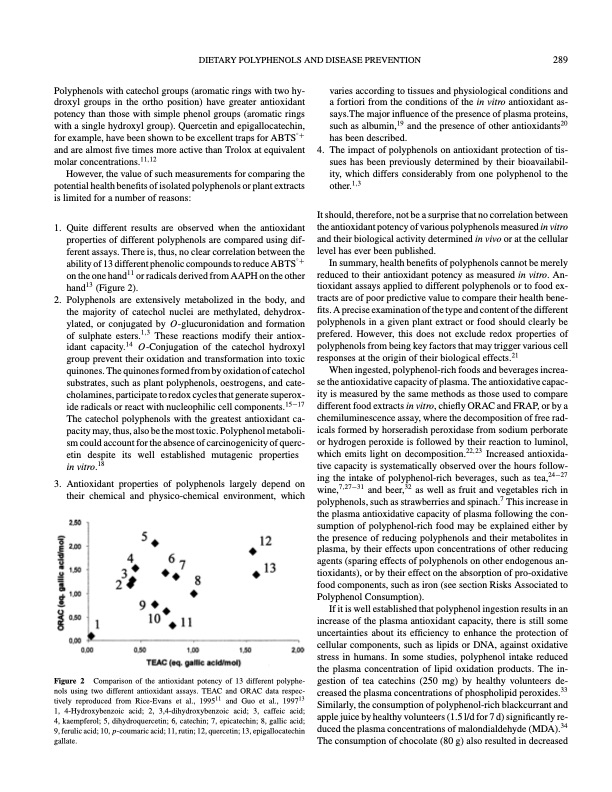
PDF Publication Title:
Text from PDF Page: 003
Polyphenols with catechol groups (aromatic rings with two hy- droxyl groups in the ortho position) have greater antioxidant potency than those with simple phenol groups (aromatic rings with a single hydroxyl group). Quercetin and epigallocatechin, for example, have been shown to be excellent traps for ABTS◦+ and are almost five times more active than Trolox at equivalent molar concentrations.11,12 However, the value of such measurements for comparing the potential health benefits of isolated polyphenols or plant extracts is limited for a number of reasons: 1. Quite different results are observed when the antioxidant properties of different polyphenols are compared using dif- ferent assays. There is, thus, no clear correlation between the ability of 13 different phenolic compounds to reduce ABTS◦ + on the one hand11 or radicals derived from AAPH on the other hand13 (Figure 2). 2. Polyphenols are extensively metabolized in the body, and the majority of catechol nuclei are methylated, dehydrox- ylated, or conjugated by O-glucuronidation and formation of sulphate esters.1,3 These reactions modify their antiox- idant capacity.14 O-Conjugation of the catechol hydroxyl group prevent their oxidation and transformation into toxic quinones. The quinones formed from by oxidation of catechol substrates, such as plant polyphenols, oestrogens, and cate- cholamines, participate to redox cycles that generate superox- ide radicals or react with nucleophilic cell components.15−17 The catechol polyphenols with the greatest antioxidant ca- pacity may, thus, also be the most toxic. Polyphenol metaboli- sm could account for the absence of carcinogenicity of querc- etin despite its well established mutagenic properties in vitro.18 3. Antioxidant properties of polyphenols largely depend on their chemical and physico-chemical environment, which Figure 2 varies according to tissues and physiological conditions and a fortiori from the conditions of the in vitro antioxidant as- says.The major influence of the presence of plasma proteins, such as albumin,19 and the presence of other antioxidants20 has been described. 4. The impact of polyphenols on antioxidant protection of tis- sues has been previously determined by their bioavailabil- ity, which differs considerably from one polyphenol to the other.1,3 It should, therefore, not be a surprise that no correlation between the antioxidant potency of various polyphenols measured in vitro and their biological activity determined in vivo or at the cellular level has ever been published. In summary, health benefits of polyphenols cannot be merely reduced to their antioxidant potency as measured in vitro. An- tioxidant assays applied to different polyphenols or to food ex- tracts are of poor predictive value to compare their health bene- fits. A precise examination of the type and content of the different polyphenols in a given plant extract or food should clearly be prefered. However, this does not exclude redox properties of polyphenols from being key factors that may trigger various cell responses at the origin of their biological effects.21 When ingested, polyphenol-rich foods and beverages increa- se the antioxidative capacity of plasma. The antioxidative capac- ity is measured by the same methods as those used to compare different food extracts in vitro, chiefly ORAC and FRAP, or by a chemiluminescence assay, where the decomposition of free rad- icals formed by horseradish peroxidase from sodium perborate or hydrogen peroxide is followed by their reaction to luminol, which emits light on decomposition.22,23 Increased antioxida- tive capacity is systematically observed over the hours follow- ing the intake of polyphenol-rich beverages, such as tea,24−27 wine,7,27−31 and beer,32 as well as fruit and vegetables rich in polyphenols, such as strawberries and spinach.7 This increase in the plasma antioxidative capacity of plasma following the con- sumption of polyphenol-rich food may be explained either by the presence of reducing polyphenols and their metabolites in plasma, by their effects upon concentrations of other reducing agents (sparing effects of polyphenols on other endogenous an- tioxidants), or by their effect on the absorption of pro-oxidative food components, such as iron (see section Risks Associated to Polyphenol Consumption). If it is well established that polyphenol ingestion results in an increase of the plasma antioxidant capacity, there is still some uncertainties about its efficiency to enhance the protection of cellular components, such as lipids or DNA, against oxidative stress in humans. In some studies, polyphenol intake reduced the plasma concentration of lipid oxidation products. The in- gestion of tea catechins (250 mg) by healthy volunteers de- creased the plasma concentrations of phospholipid peroxides.33 Similarly, the consumption of polyphenol-rich blackcurrant and apple juice by healthy volunteers (1.5 l/d for 7 d) significantly re- duced the plasma concentrations of malondialdehyde (MDA).34 The consumption of chocolate (80 g) also resulted in decreased DIETARY POLYPHENOLS AND DISEASE PREVENTION 289 Comparison of the antioxidant potency of 13 different polyphe- nols using two different antioxidant assays. TEAC and ORAC data respec- tively reproduced from Rice-Evans et al., 199511 and Guo et al., 199713 1, 4-Hydroxybenzoic acid; 2, 3,4-dihydroxybenzoic acid; 3, caffeic acid; 4, kaempferol; 5, dihydroquercetin; 6, catechin; 7, epicatechin; 8, gallic acid; 9, ferulic acid; 10, p-coumaric acid; 11, rutin; 12, quercetin; 13, epigallocatechin gallate.PDF Image | Dietary Polyphenols and the Prevention of Diseases

PDF Search Title:
Dietary Polyphenols and the Prevention of DiseasesOriginal File Name Searched:
Grapes-Polyphenolics-Health.pdfDIY PDF Search: Google It | Yahoo | Bing
Cruise Ship Reviews | Luxury Resort | Jet | Yacht | and Travel Tech More Info
Cruising Review Topics and Articles More Info
Software based on Filemaker for the travel industry More Info
The Burgenstock Resort: Reviews on CruisingReview website... More Info
Resort Reviews: World Class resorts... More Info
The Riffelalp Resort: Reviews on CruisingReview website... More Info
| CONTACT TEL: 608-238-6001 Email: greg@cruisingreview.com | RSS | AMP |